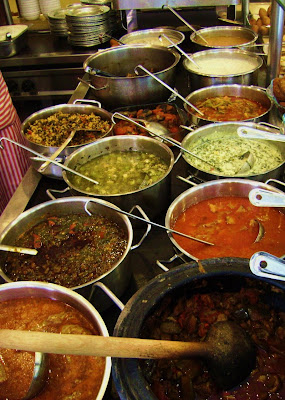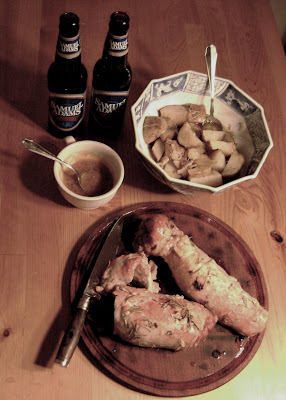
In one of life’s strange twists of fate, Ms Vidal and I recently found ourselves in Turkey where we made a careful, albeit too brief, lay of the culinary land. Let me assure you, dear reader, that in a world where the seas are made of bullshit and the rivers are rising, Turkey counts itself among the higher elevations left to be subsumed.
Like a classical Hong Kong, Istanbul embraces one of Earth’s most beautiful waterways, spilling from numerous hilltop enclaves down alleys, stairs, avenues and even a 19th century funicular to its bustling quays whence ships of every description ply the sparkling juncture of the Bosporus and the Golden Horn.
It is one of God’s maxims that every great city is built on water and by extension that a city’s greatness lies in direct proportion to the greatness of its aquatic setting. From Bangkok to Barcelona, Mumbai to Montevideo, the great cities of the world draw on their waterways for ablution and replenishment. Remove the Seine from Paris or the Neva from St Petersburg and those cities radically veer towards the Houstonian.
Istanbul is defined by water, delineated into three zones with a temperament unique enough to each to create the impression that three cities compose the great metropolis.
The Bosporus is Istanbul’s central axis, dividing the city into European and Asian halves. Though half the width of the Delaware River at Wilmington, the Bosporus teems with a flotilla of yachts, pleasure boats, row boats, fishing boats, dinghies, passengers ferries linking the two halves of the city, passenger ferries linking the city to Turkish and foreign destinations as far a field as Venice and Odessa, as well as thousands of freighters hauling oil and manufactured goods to and from Eastern European ports.
The European half of the city is cut in two by the Golden Horn, a freshwater inlet that, along with the Sea of Marmara, defines the peninsula of Old Istanbul. Sultanahmet lies here, the modern name for the ancient city inside the six miles of Roman walls that withstood conquest for a thousand years before the Ottomans finally blew them down and seemingly devoted themselves to the frenzied construction of mosques. Sultanahmet covers a ridge, and from afar the crest of that ridge bristles with minarets.

Across the Golden Horn, vast neighborhoods, unconstrained by the cut of the land, sprawl north and west over the hilltops. Far from the madding crowds of tourists and polyglot hucksters who have transformed Sultanahmet into a theme park, this is the true heart of the European side. Taksim Square, the northern terminus of Istiklal Caddesi or Independence Avenue, is its center.
On weekend nights thousands upon thousands of Turks crowd the square, milling under the charcoal smoke of corn and chestnuts roasting on braziers, to stroll down Istiklal Caddesi. Istiklal, formerly the Grand Rue de Péra, descends from Taksim at a gentle grade, following a ridgeline, and veers to the left halfway to its southern terminus at Tünel Square. From here the Tünel funicular, completed in 1875, drops off the steep ridge to the waterfront neighborhood of Karakoy, sixty meters below.
Strolling the Taksim - Tünel circuit is what’s doing weekend nights. The only vehicle admitted on the avenue is an old red trolley, reminiscent more of the functioning wooden workhorses of Lisbon than San Fransisco’s rolling schlock. The limitation of vehicles is a good thing, because the sheer human volume that floods Istiklal on a warm spring weekend night barely fits between the walls of the avenue. Lights are strung above them, from one side to the other, and the din of ten thousand conversations held at once echoes down from the upper stories of 19th century apartments. Midway in the circuit is the Galatasaray Lisei, a palatial boarding school (one of the country’s finest) that lies on private grounds behind a forty-foot-high marble-columned gateway.

Nearby, Sahne Sokak, a narrow side street, splits off from Istiklal and drops off the ridgeline. It is a vortex, sucking an improbable percentage of the larger avenue’s pedestrian traffic into its far smaller confines. Both sides of the street (it is more of an alley really) are lined without interruption by restaurants, bars, open kitchens, and displays of everything from manually operated brass coffee grinders to skinless goat heads to bright-eyed shining caught-that-morning-and-delivered-still-flapping-on-a-tray-of-ice fresh fish in every shape and size the trifecta of Black, Aegean and Marmaran seas are able to proffer.
At first glance, one could be forgiven for thinking of la Rue de la Huchette, but take another look at those fish and you’ll see the difference. There are bright five-inch long red mullet, their eyes slightly bloodshot; bright, gilt-head bream, sacred to Aphrodite; fresh small blue fish no bigger than a girl’s hand; shining firm-bodied blue fish as long as your arm and as athletic as jaguars; the tails of enormous tuna; skate hanging from hooks; silver sardines piled in wooden crates like plump knitting needles; bright bodied, wide-eyed whiting; and alabalık, an endangered freshwater member of the salmon family. Some of the fish, unwilling to go gently, give a furious flap of the tail to passersby.
The flow of human traffic veers again, sucked into the steeper and narrower confines of Nevizade Sokak. Above the crowd, on open terraces and at open windows of the upper floors, happy Istanbulus look down from their enviable perches. Lights are strung from building to building and past these, in the darkness, the street seems to plunge down a drain. People peel off from the tumult, ducking into the parlors of the meyhanes, or taverns, that line both sides of the street.
In the meyhanes, crowded elbow to elbow, they find privacy in the few square feet they share across a table. Small groups of friends spend hours together, eating small portions of cold dishes called mezze they order off a tray, sharing fish bought straightaway from the displays around the corner, smoking continually and drinking small, ceremoniously prepared glasses of rakı, the Turkish answer to pastis. The mezzes are simple: a dish of olives or pickled artichoke heart, indescribably tender fava beans, puréed eggplant, white ewe’s milk cheeses, tender white-fleshed eggplant stewed in tomato sauce, all of this accompanied by fresh loaves of crusty bread. Fish is prepared simply, battered and deep fried in the case of calamari and red mullet (the calamari tender as butter; the rich red mullet, eaten head and all, without a trace of fishiness), or simply fried on the skillet and served whole in the case of the gilt-head bream, which has flesh as firm and a flavor as clean as brook trout caught in the morning and eaten in the afternoon.

In the workaday shuffle of Istanbul, the largest city proper and second largest metro area in Europe, and the fourth largest city proper in the world (only Karachi, Shanghai and Mumbai are bigger), people rarely have time for the leisurely hours of the meyhane. Instead they dart into places like the Can Ciğer – Edirne Tava Ciğeri on Barbaros Boulevard in Beşiktaş, a neighborhood north of the Golden Horn.
Ciğer means liver and that is what they serve. It comes sliced and deep-fried, accompanied by two Anaheim peppers deep-fried to a bronze, a sliced tomato and raw white onion. Despicably tender, the liver has none of that rubber boot chewiness one has lamentably come to expect from liver and onions in most restaurants. Eaten with a bit of chili, which is hot enough to temper but not drown the liver flavor, a slice of cool tomato and a pungent sliver of raw onion, this classic standby undergoes a welcome transformation.

Barbaros Boulevard is named after Barbarossa, or Red Beard, the Barbary pirate who retired to the erstwhile village of Beşiktaş after bringing North Africa under the Ottoman yolk. Since absorbed by the expanding city, Beşiktaş is a busy hub at the nexus of two major roads and one of Istanbul’s principal ferry terminals. Far from being quaint pleasure cruises, Istanbul’s ferries form an integral part of the city’s mass transit system. The crossing from Beşiktaş to Kadikoy, on the Asian side, takes under half an hour and enables you to see Istanbul as it was meant to be seen, bristling across the hilltops and back-lit by the evening sun.

Kadıköy, the former Bithynian city of Chalcedon, is the heart of Asian Istanbul. In the evening, its narrow, sloping streets fill with residents out shopping at vegetable and fish stands offering some of the freshest and most widely varied assortment of green and scaled grocery this writer has seen in thirty-six countries. For centuries, Kadıköy has been a melting pot on the edge of the metropolis where Armenians, Kurds, Arabs, Jews, Turks, and Greeks plied their wares, and exchanged culinary methods and ingredients, at the threshold of Europe.

Fittingly, Kadıköy is home to one of the world’s great restaurants, perhaps the best in Turkey. Çiya Sofrasi is the creation of Musa Dağdeviren, a swarthy, mustachioed, half-Kurdish half-Turkish forty-nine-year-old Quixote who started work in a bakery when he was five. In 1987, having spent his twenties as a migrant apprentice in the kebab joints of Istanbul, Dağdeviren launched the first of what are now three restaurants. The jewel of the triad is Çiya Sofrasi. Sofrasi is a restaurant serving salads, soups and stews, but that doesn’t hint at the complexity, depth and variety of what happens in this magical restaurant.

Çiya is a living encyclopedia of Near Eastern regional cooking on a microcosmic scale; an encyclopedia, in practice, of food produced in hamlets and valleys still isolated enough to retain an essential terroir. It is a concept restaurant in the extreme, yet, without demeaning the food one bit, I’m not sure what they’re doing here is cuisine. Instead, hundreds of recipes unique in their unusual ingredients, culinary style and ethnic heritage are collected and recreated in a humble setting. The intent is not to overawe with molecular gastronomy arranged in geometric patterns and bathed in foam. The intent, seemingly, is to transport its visitors to tiny pockets of humanity yet to be swallowed by the relentless homogenization of history by serving, and preserving, what Dağdeviren calls “the food of real people.”

Happily, those real people are cooking phenomenal food. At Çiya Sofrasi, on any given day, you select your meal from two buffets (one hot, one cold), which offer between them several dozen dishes chosen from the hundreds of recipes in the restaurant’s repertoire. In two visits, I tried cold stuffed dried eggplant, cold stuffed dried red peppers, stuffed grape leaves, bulgur wheat with mint, braised ferns, coarse cat-tongue textured greens, bitter salad, garlic braised greens, julienned light lettuce-like greens, elegant humus, a fiery red pepper caviar, pickled beats, stuffed dried eggplant braised with lamb bones, tomato lamb and eggplant stew, yogurt soup, braised bulgur wheat “meatballs” blackened over fire, lamacun, braised stuffed intestines, and a soup made from mushrooms the size of baseballs with the texture of water chestnuts and the flavor of freshly picked chanterelles.

For this eater, the true hallmark of a great cuisine is how satisfyingly its vegetarian components fare against their bleating, clucking and mooing kin. An unrepentant carnivore, I find most vegetable dishes, no matter how complex, fail in flavor or satisfaction to match a pork rib, let alone a lamb chop, cooked with nothing but salt over fire. Besides the awesome task of envisioning and building this sanctuary for endangered foods collected from the tiny pockets of humanity, so dissimilar in the nuances of their localities and yet so common in their responses to them, still flickering at the event horizon of an expanding, all-swallowing blandness, Mr Dağdeviren’s great triumph lies in recreating in the plenitude of a vast modern city the satisfaction snow-bound villagers achieved with few available ingredients gathered within the limits of their surroundings and cooked with a superabundance of ingenuity, desperation and, ultimately, love.


















